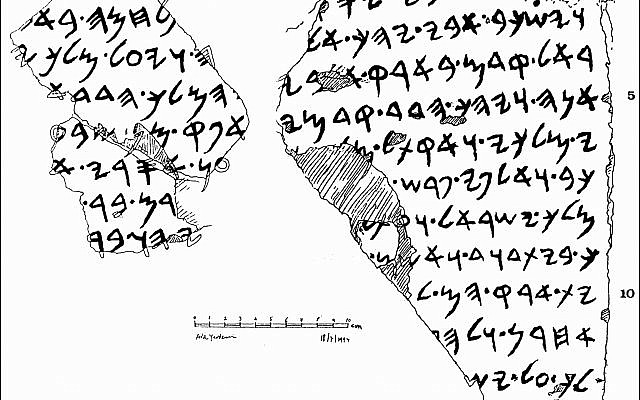A network of fortified cities around Jerusalem has been dated to the time of King David, more than 200 years earlier than previously thought, offering support to the theory that King David ruled over a complex and large kingdom. The proof, however, wasn’t freshly excavated from the earth, but rather came to light after an archaeologist spent years digging through old archaeological publications.
In a new academic paper, Prof. Yosef Garfinkel of the Institute of Archaeology at Hebrew University claims he has found evidence of urban settlement in organized cities dating to around 1,000 BCE, during the reign of King David.
His article, published Monday in the Jerusalem Journal of Archaeology, a peer-reviewed publication of Hebrew University, supports the theory that King David ruled over a well-developed kingdom, complete with roads connecting between cities. This runs counter to the belief of some scholars from the minimalist school of thought who have previously suggested that since there is scant evidence of cities during King David’s reign, his position as a ruler of a great kingdom as written in the Bible could be exaggerated.
“What is a kingdom?” countered Garfinkel. “You need cities and roads and military power and economic power and writing.”
Garfinkel’s paper, “Early City Planning in the Kingdom of Judah: Khirbet Qeiyafa, Beth Shemesh 4, Tell en-Naṣbeh, Khirbet ed-Dawwara, and Lachish V,” explores evidence of King David’s rule in five cities that were between half a day and a day’s walk from Jerusalem.
“If you take all these sites, they have the same urban concept, they are all sitting on the border of the kingdom and sitting where you have a main road leading to the kingdom,” he said. “These cities aren’t located in the middle of nowhere. It’s a pattern of urbanism with the same urban concept.”
Minimalist thinking
However, there is still little archaeological evidence of an organized monarchy from the assumed time of King David’s reign in the two places where he is recorded in the Bible as having spent the most time: Hebron and Jerusalem.
The story of King David has vexed experts for decades since so little evidence remains of the rule of the glorious and complicated biblical king. “I can take a shoebox and put inside everything we have from that period,” Yuval Gadot, an archaeologist from Tel Aviv University, told the New Yorker in 2020 about evidence in Jerusalem from King David’s reign.
In fact, the first evidence that a leader named David existed only appeared in 1993, when archaeologist Avraham Biran discovered an inscription at Tel Dan in northern Israel that referred to “The House of David.”

The Tel Dan stele mentions, ‘House of David.’ It was discovered by Avraham Biran in 1993. (courtesy Prof. Yosef Garfinkel)
There are two major schools of archaeological thought about King David: the “minimalist” school, which holds that David was a local Bedouin leader who ruled over a few thousand Bedouin shepherds in the vicinity of Jerusalem. The other school of thought hews more closely to the Bible’s depiction of King David as the ruler of a vast and complicated kingdom.
Garfinkel’s paper, which points to an urban network of fortified cities that was part of the kingdom of David, supports a reading closer to the Bible’s depiction of David.
“I hate to use the term ‘trying to prove the Bible,’ because I’m not trying to prove anything,” said Garfinkel. “There are biblical traditions, and we can see if these have historical memories or not… It doesn’t mean that everything, 100 percent, is historical memories. Sometimes there are mistakes, sometimes there is wishful thinking, sometimes there is ideology.”
Garfinkel cautioned against subscribing to extremes in either school of thought. “Some people think that everything [from the Bible] is useful, and some think nothing is useful, but that’s not science, that’s theology,” he said.
Other archaeologists disagree with Garfinkel’s interpretation, even if they don’t entirely accept the minimalist approach.
“I think it’s an oversimplification and he is flattening the details,” said Prof. Aren Maeir, of Bar Ilan University. “There’s a lot of small details I don’t agree with, and there are generalizations over a wide period that are problematic.”
For example, there’s controversy around whether Khirbet Qeiyafa, which Garfinkel cited as one of the cities in the network, was actually a Judahite or Canaanite city, Maeir said. “Once you start building a whole scenario of the size of the kingdom at various points, and they’re based on not clearly proved suppositions, you’re building a house of cards,” he said.
Maeir believes that there was a historical King David who ruled over a kingdom in Jerusalem, but he hasn’t seen enough evidence to clearly state the size or complexity of the area under King David’s rule.

Prof. Aren Maeir in the lab of the Tell es-Safi/Gath Archaeological Project at Bar Ilan University (courtesy)
“It’s like when a fisherman tells you about the type of fish he caught and with each story, his arms get wider and wider,” said Maeir. “Is it a sardine, a mackerel, or a blue whale? If you read the biblical text and take it literally, then it’s a blue whale. I think that probably there was a small kingdom in Jerusalem, but we don’t know the influence that this kingdom had.”
“As archaeologists, we take the finds and we try to interpret them as best as we can,” he added. “Sometimes, interpretations can go a little too far, and I think we all do this… It’s important to put out the ideas there, even if they’re not accepted. But it’s also important to clarify when things are rock solid and when they’re interpretations.”
Previously, Garfinkel had raised some controversy by claiming he and others had discovered the 3,000-year-old city of Ziklag, a place mentioned in the Bible as David’s refuge when he fled Saul, which other archaeologists questioned.
A map of the city
Garfinkel found that all five cities he included in the study had roughly the same layout, with an outer wall, dwellings abutting the wall on one side and facing a road on the other side. In three of the cities, there was a “casement” wall, which means there are two parallel walls surrounding the city rather than a solid outer wall. The casement walls were much quicker to build than solid walls, required fewer materials, and also provided a place for dwellings in the space between the walls. If the city was facing an attack from a certain side, its defenders could quickly fill in the space between the casements to create a solid wall.

An aerial view of the casements of the city wall of Khirbet Qeiyafa, which were used as dwellings or storage. (courtesy Yosef Garfinkel)
Additionally, a number of proto-Canaanite and Canaanite inscriptions were found in some of the sites, indicating an increased demand for communication that is the mark of a centralized authority and strong kingdom, Garfinkel claims.
Because the sites were excavated independently and with varying levels of archaeological practice, Garfinkel’s paper is the first to link these sites into an organized urban network around 1000 BCE. King David reigned from approximately 1104 – 960 BCE, during the Iron Age.
“The evidence was known before; it is not a matter of new discoveries. What was needed was someone to come along and observe the complete picture that these findings portray,” he said.

Prof. Yosef Garfinkel of the Institute of Archaeology at Hebrew University. (courtesy Hebrew University)
To dig is nice, but the real work is publishing
Garfinkel personally excavated just two of the five sites in the urban network – the northeastern part of Lachish, and Khirbet Qeiyafa IV, which is located in the Elah Valley, about a day’s walk from Jerusalem.
Garfinkel said that Khirbet ed-Dawwara, which leading Israeli archaeologist Prof. Israel Finkelstein excavated in 1985-1986, provided one of the breakthroughs because it was inhabited for just 30 years and then abandoned, so it provided one of the clearest pictures of what a city layout looked like during the time period.
Other sites were excavated long ago, some about a century ago. Beit Shemesh has been excavated since 1911, while Tell en-Nabeh was excavated completely between 1926 and 1935.
“Many of these cities were not well-excavated, or it’s an old excavation,” Garfinkel explained. “The main problem we have in Israel is that most of our archaeological sites are ‘tels,’ which means that many cities were built on top of one another. The most important of archaeology here is to make sure you are separating Level 1 from Level 2 from Level 3 from Level 4.”
“In the past, they weren’t as aware of doing this, and you also had just 1-3 archaeologists and between 70 and 150 workers at a site. So when they were in the field, they often combined various levels, and the picture was blurred,” he said.

A closeup of one of the casements in the city wall of Khirbet Qeiyafa during the excavations in 2007-2013. (courtesy Yosef Garfinkel)
Additionally, Ottoman practice from the 1930s was that a site would be excavated and then covered over to allow the owners to continue using it for agriculture, so some of the findings got mixed up as the site was filled in again, Garfinkel said.
Garfinkel combed through old archaeology publications from the 1930s to contemporary editions to try to organize the jumbled findings into the more ordered levels that archaeologists use today.
“This information was hiding in these reports,” he said.
The recent article, however, also highlights what Garfinkel believes is the cornerstone of the field of archaeology: publication.
“To dig is very nice, you go out and dig for one month,” he said. “But you’re researching and writing for three or four years afterward based on that month. Many excavations in Israel have never been published, and publication is the most important part of archaeology.”













